
May 29, 2017, by Ian Kingsbury
US Library fact-finding trip
By Beth Massey, Education Officer, Students’ Union
Last year, I was invited to travel on an exploratory visit to the United States with Libraries, Research and Learning Resources (LRLR) Director, Caroline Williams and Associate Director for Customer Service, Sue Storey. Covering three cities and four quite different universities, we were looking for innovative approaches to the library experience and to explore the next generation of technology in those spaces.
First stop – Ohio
We flew into Columbus, Ohio for our first visit to Ohio State University, a partner institution through Universitas 21 and a large “land grant” public university.
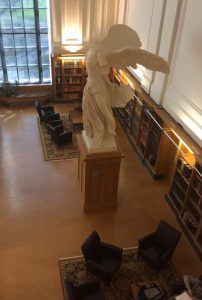 After a rather interesting first 48 hours involving a tornado warning, we visited the Thompson Library at Ohio State. The first thing that struck me was the sheer size and scale of the campus and the Thompson Library itself. Ohio State has around 55,000 undergraduate students and a library to match. It is even home to the world’s fourth largest (non-racing) stadium with a capacity of nearly 105,000 for its American Football games.
After a rather interesting first 48 hours involving a tornado warning, we visited the Thompson Library at Ohio State. The first thing that struck me was the sheer size and scale of the campus and the Thompson Library itself. Ohio State has around 55,000 undergraduate students and a library to match. It is even home to the world’s fourth largest (non-racing) stadium with a capacity of nearly 105,000 for its American Football games.
Here at the University of Nottingham we have our Manuscripts and Special Collections over at King’s Meadow Campus. The Ohio State students are lucky enough to have this housed within their main library, with interesting exhibits displayed on the ground floor which appeared not only relevant to the university spirit but also very popular!
But the most striking aspects of the Thompson Library were its many high-ceiling reading rooms. These were where the majority of students chose to study, with the rooms achieving a real mix of study atmospheres. Books were housed in the central tower of the library, with the shelves built into the library’s support structure – unfortunately not very attractive. However the reading rooms provided light and open environments that were extremely popular with students and made for great locations to display artworks – a necessity for generating income in the world of publically-funded universities.
The Windy City
The most exciting of all the places we visited was Chicago. We had 24 hours here – almost to the minute – with one planned visit to the prestigious University of Chicago. A private university, the University of Chicago has a very different student make-up to that of Nottingham. Around half the size of the UoN, most of its students are postgraduates (almost 10,000 compared to 6,000 undergraduates).
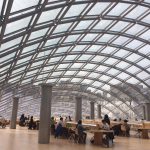 Our reason for visiting was the relatively new Joe and Rika Mansueto Library, a large domed reading room with an enormous book vending machine reaching 50 feet below the reading room. Interestingly the land this library was built on was the site of the first human-made self-sustaining nuclear chain reaction which formed part of the Manhattan Project. The reading room was spectacular with lots of open, bright space thanks to the glass dome. However, the cost of the library including the book vending machine was immense. Given its seemingly limited usage and the fact it is only half filled with books leads me to believe that, whilst an effective space saver, it does not really offer value for money when you consider the price tag north of $70million.
Our reason for visiting was the relatively new Joe and Rika Mansueto Library, a large domed reading room with an enormous book vending machine reaching 50 feet below the reading room. Interestingly the land this library was built on was the site of the first human-made self-sustaining nuclear chain reaction which formed part of the Manhattan Project. The reading room was spectacular with lots of open, bright space thanks to the glass dome. However, the cost of the library including the book vending machine was immense. Given its seemingly limited usage and the fact it is only half filled with books leads me to believe that, whilst an effective space saver, it does not really offer value for money when you consider the price tag north of $70million.
Nonetheless it was certainly impressive, with a significant amount of space dedicated to the preservation, digitization and conservation of manuscripts and special collections and a stunning “Grand Reading Room”. I have become convinced that large, bright, open reading rooms are a very positive move and I will be heartily encouraging the university to consider them in its future capital projects.
Last stop – North Carolina
Our final hop was over to North Carolina where we visited two universities: North Carolina State and Duke University. I’ll cover Duke University first, although it was our final visit, because I want to save the best until last!
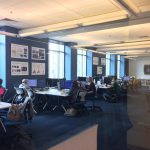 Duke University, like the University of Chicago, is a relatively small, private university with more postgraduate students than undergraduates. Built at the same time as our own Trent Building, architecturally Duke University would be at home in some of the older Oxbridge colleges and presents an imposing picture. One of the world’s best universities, academically and physically through its sporting programmes, it’s the seventh wealthiest private US university with a whopping $11.4 billion in cash and investments back in 2014. Our visit focused on the recently opened The Edge:
Duke University, like the University of Chicago, is a relatively small, private university with more postgraduate students than undergraduates. Built at the same time as our own Trent Building, architecturally Duke University would be at home in some of the older Oxbridge colleges and presents an imposing picture. One of the world’s best universities, academically and physically through its sporting programmes, it’s the seventh wealthiest private US university with a whopping $11.4 billion in cash and investments back in 2014. Our visit focused on the recently opened The Edge:
“a collaborative space for interdisciplinary, data-driven, digitally reliant or team-based research”.
Home to project spaces, data and visualisation suites and a digital studio, The Edge provides cutting edge technology (plus support) to both staff and students. Individuals can learn digital literacy skills through workshops run by students and supported by staff. Again, Duke houses a number of reading rooms which vary from older Oxbridge-style colleges to newer open, bright spaces so this is clearly something we need to replicate! Perhaps we’ll also end up with $11 billion to play with in future…
Cutting edge of tech
Finally we visited North Carolina State University and the spectacular Hunt Library. North Carolina State is more akin to Nottingham with roughly 34,000 students, the majority of which are undergraduates. It’s a publically-funded, land grant university like Ohio State University too.
The Hunt Library is not a library in any traditional sense of the word, I would suggest that students do not visit this space to collect books so much as they visit to study and use the technology that this building has bursting at the seams. The Hunt Library utilises their book vending machine – affectionately named BookBot – far more than the previous example, and enables students to browse shelves in the more conventional sense through an app, again unlike the University of Chicago. The BookBot saves space on a ratio of 9:1 which is incredibly impressive but, again an expensive solution. There are only a handful of books visible in the main areas of the library, as dictated by the results of student feedback.
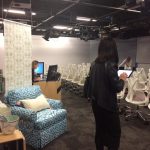 With the space saved by the BookBot, the Hunt Library offers around 75 different styles of chair in over 100 different colours. This may sound excessive but – wow – it was amazing. It gives individuals the opportunity to really find their little piece of home within the library, whether that be in an Egg Chair overlooking the road, a deckchair in the middle of the library or a lounging chair overlooking a beautiful lake view. The number of chairs does not feel excessive with seamless integration of styles and a general sense of variety that we always get from student feedback.
With the space saved by the BookBot, the Hunt Library offers around 75 different styles of chair in over 100 different colours. This may sound excessive but – wow – it was amazing. It gives individuals the opportunity to really find their little piece of home within the library, whether that be in an Egg Chair overlooking the road, a deckchair in the middle of the library or a lounging chair overlooking a beautiful lake view. The number of chairs does not feel excessive with seamless integration of styles and a general sense of variety that we always get from student feedback.
Despite opening in 2013, the Hunt Library is very much at the cutting edge of technology. It has a Games Lab for its game design studies but, when not in teaching use, students can borrow games controllers to play on its vast array of consoles. It also has a creativity studio which has been used for Naval-style training as movable walls help to create divisions in space that can be mapped to create different environments. One room we saw enables 270° visual immersion where one student was preparing to deliver her Masters Viva. It also has video, media and music production suites.
Final thoughts…
I think we all felt that it would have been quite nice to have dug up the Hunt Library and flown it back to the UK for relocation on Jubilee Campus!
My visit to the US with LRLR was incredibly eye-opening. To have the opportunity to visit and explore some of the great library investments of the last five years has given me many ideas and things to consider for future capital investment projects here at Nottingham. Being able to provide a student perspective on the many places we saw was a valuable check on what could be perceived as excessive or over the top in a world where tens of millions of dollars appear to be thrown around in order to better students’ academic experiences. I am sure that this visit will serve as a valuable exploration into what is possible and what solutions we should be providing as a university of the future.
Key messages that I have brought back here to Nottingham are:
- Double height reading rooms are absolutely awesome and we really don’t make enough of these kinds of study spaces in this country, let alone this university.
- US universities have a lot more money to play around with based on very different funding models, with alumni and public donations being much greater than in the UK.
- Greater early investment in cutting-edge technology can really future proof a library.
- Nottingham students are extremely lucky to have such a good staff/student relationship with our Libraries, Research and Learning Resources team, one which was not reflected in any of the US universities that we visited!
- Libraries are no longer a place to just pick up books, they are becoming places where students can relax and feel at home whilst studying.
The gallery
- Blue sky thinking…the journey begins
- Special Collections are on open display at Ohio State
- High ceilings – tick. Unattractive architecture – cross
- Domed reading room of the Rika Mansueto Library, University of Chicago
- First of two book vending machines
- Trent Building-era architecture of Duke University
- The Edge – cutting edge tech
- Bookbot number two – see the video above
- Decisions, decisions…75 types of chair in 100 colours
- 70s chic, maximum comfort
- The three amigos? Beth, Caroline and Sue
No comments yet, fill out a comment to be the first


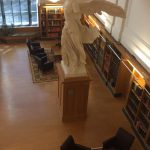
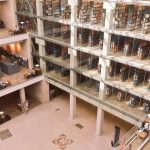
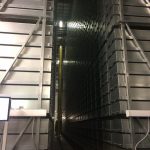
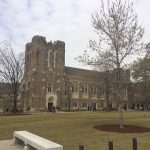
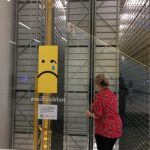
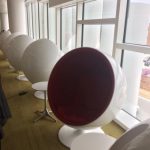
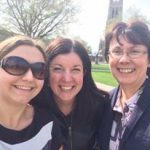
Leave a Reply